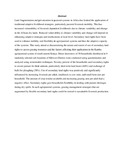Analysis Of Secondary Land Rights For Adaptation In Climate Driven Agropastoral Systems Of South Eastern Kenya

View/
Date
2011Author
Nyangito, M.M.
D.M., Nyariki
Hjort, A.
Farah, K.O.
Musimba, N.K.R.
Type
PresentationLanguage
enMetadata
Show full item recordAbstract
Land fragmentation and privatization in pastoral systems in Africa has limited the application of
traditional adaptive livelihood strategies, particularly pastoral livestock mobility. This has
increased vulnerability of livestock dependent livelihoods due to climate variability and change
in the African dry lands. Reduced vulnerability to climate variability and change will depend on
enhancing adaptive strategies and mechanisms at local level. Secondary land rights have been
used to enhance mobility and flexibility in agro/pastoral systems and thus the adaptive capacity
of the systems. This study aimed at characterizing the nature and extent of use of secondary land
rights to access grazing resources and the factors affecting their application in the Kamba agropastoral
system of south eastern Kenya. Direct interviews of 50 households distributed in 9
randomly selected sub-locations of Kibwezi District were conducted using questionnaires and
analyzed using econometric techniques. Seventy percent of the households used secondary rights
to secure pasture for their animals, particularly short term land leases (64%) and exchange of
bulls for ploughing (38%). Use of secondary land rights was positively and significantly
influenced by increasing livestock per adult, smallstock to cow ratio, and small farm size per
household. The amount of crop residue available and increasing grazing area per adult had a
negative effect. Secondary rights gave households flexibility in dealing with pasture shortages
during dry spells. In such agropastoral systems, grazing management strategies that are
augmented by flexible secondary land rights could be central to sustainable livestock production.
